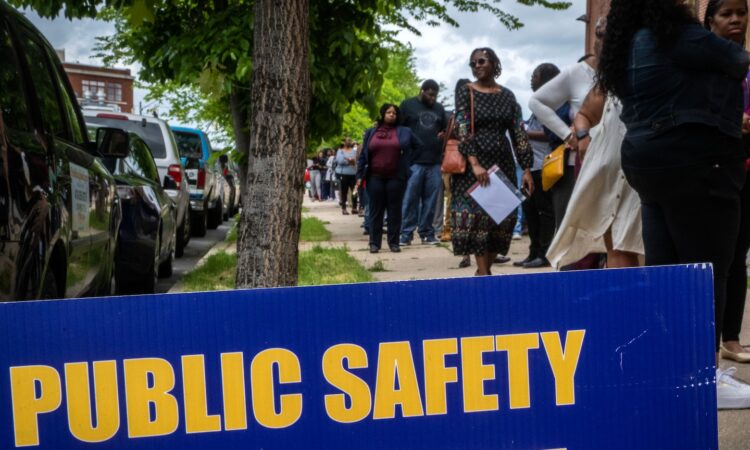
The April jobs report, which beat economists’ forecast yet again, showed the 28th straight month of solid job growth. The remarkable strength of the pandemic recovery labor market, despite some softening, is buoying the U.S. economy through enormous uncertainty. Jobless benefit claims have been slowly inching up but still show no signs of an economic downturn.
“You’re really not seeing any indicators in the labor market that a recession is on the horizon,” said Kathryn Edwards, a labor economist at the Rand Corporation. “All of the forecasts of a recession are coming from outside the labor market.”
Wages, which have been growing above expectations complicating the Federal Reserve’s inflation fight, continued to rise in April, with average hourly earning growing by .5 percent, to $33.36.
Payrolls continued to swell in industries that provide services, with the largest gains in professional and business services, health care, leisure and hospitality, and social assistance.
Meanwhile, construction, manufacturing, wholesale trade, retail trade, transportation and warehousing saw little change.
Job gains for March and February were revised downward by roughly 70,000 jobs each to 165,000 and 248,000, respectively, in yet another sign that the labor market is cooling from its peak.
Federal Reserve Chair Jerome H. Powell said on Wednesday that he remains optimistic that the United States can narrowly avoid a recession thanks to the ongoing resilience of the labor market which has persevered in the face of more than a year of aggressive interest rate increases.
“We’ve raised rates by 5 percentage points in 14 months and the unemployment rate is 3.5 percent — pretty much where it was, even lower than it was when we started,” Powell said. “It wasn’t supposed to be possible for job openings to decline by as much as they’ve declined with our unemployment going up. Well, that’s what we’ve seen.”
Still, Powell said, there are “no promises,” and he didn’t rule out the possibility of an economic slump. “It’s possible that we will have what I hope would be a mild recession,” Powell said. Federal Reserve officials will be closely monitoring economic indicators over the next month, including Friday’s jobs report, to determine whether Wednesday’s interest rate hike will be the last for a while.
The U.S. economy is souring on a number of other fronts. The country’s economic growth slowed in the first quarter of 2023, growing at an annual rate of 1.1 percent as manufacturing outputs and retail sales have fallen. The spring’s banking crisis is sending shock waves through financial markets, leading banks to become less willing to lend, which is needed for business growth and hiring. That can slow the economy further.
Despite its resilience, the labor market appears to be cooling off. Employers have more leverage over workers than they had a year ago. The pace of job creation, with some exceptions, has tempered notably during the past two years, falling to its lowest level in March since December 2020.
Major companies, including Lyft, Deloitte, Facebook’s parent company Meta and Whole Foods have announced mass layoffs in recent weeks. Most of the layoffs have been concentrated within tech, financial services and housing, industries that boomed during the pandemic.
Layoffs and discharges jumped in March, returning to a typical pre-pandemic level, according to a Labor Department job openings report released Tuesday. And a slight rise in claims for unemployment benefits over the past few weeks suggest that some laid off workers are not finding new jobs as easily as a few months ago.
“If you’re in a situation where you’ve lost your job and you’re in an industry that’s undergoing a lot of layoffs, you might be starting to get concerned about your ability to find a job again,” said Guy Berger, principal economist at LinkedIn.
Meanwhile, overall job openings also fell to 9.6 million in March, the lowest number in nearly two years, in a sign that the Federal Reserve’s interest rate hikes are working to dampen demand for workers. At the height of the hot labor market marked by worker shortages, there had been two jobs for every unemployed worker. Now that rate has fallen to 1.6 jobs for every unemployed worker.
“There’s steam coming out of the labor market,” Berger said. “Workers are losing their bargaining power. The pendulum is swinging toward employers.”
More Americans who left the workforce during the pandemic have returned to their jobs, easing labor shortages. The labor market has regained 75 percent of the 4 million workers who dropped out of the workforce during covid due to retirements, lack of child care and health concerns, according to an analysis by The Washington Post.
Chelsey Popanz, a mother of two young children in Cassville, Mo., spent the pandemic hopping in and out of the workforce based on the availability of affordable child care. She held jobs as a zookeeper, hotel bartender, casino bartender, and banquet captain. She also spent months out of work when her fiance could support their household on his $19.75 an hour paycheck as a welder.
Now Popanz is firmly back at work as a 911 operator on the night shift, making $16.80 an hour. Popanz said she was drawn back to work through a combination of finding a decent-paying job for the area, getting child care thanks to her extended family’s help and needing more money to cover rising prices of gas, food and utilities.
“The only reason I came back is because I need the money,” said Popanz, 26. “I personally would love to stay home with my kids. But financially, we’re probably bringing in $5,000 to $6,000 a month and we literally have nothing to show for it because of our bills. We’re getting by with a little bit left over but not enough to thoroughly enjoy life.”






